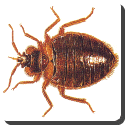 Bedbug — Bedbugs (or bed bugs) are small nocturnal insects of the family Cimicidae that live by hematophagy, that is by feeding on the blood of humans and other warm-blooded hosts.
Bedbug — Bedbugs (or bed bugs) are small nocturnal insects of the family Cimicidae that live by hematophagy, that is by feeding on the blood of humans and other warm-blooded hosts.
The common bedbug (Cimex lectularius) is the best adapted to human environments. It is found in temperate climates throughout the world and has been known since ancient times. Other species include Cimex hemipterus, found in tropical regions (including Florida), which also infests poultry and bats, and Leptocimex boueti, found in the tropics of West Africa and South America, which infests bats and humans. Cimex pilosellus and C. pipistrella primarily infest bats, while Haematosiphon inodora, a species of North America, primarily infests poultry.
Adult bedbugs are a reddish brown, flattened, oval, and wingless, with microscopic hairs that give them a banded appearance. A common misconception is that they are not visible to the naked eye. Adults grow to 4 to 5 mm (one-eighth to three-sixteenths of an inch) in length and do not move quickly enough to escape the notice of an attentive observer. Newly hatched nymphs are translucent, lighter in color and continue to become browner and moult as they reach maturity. When it comes to size, they are often compared to lentils or appleseeds.
A recent paper by Professor Brian J. Ford and Dr Debbie Stokes gives views of a bedbug under various microscopes.
Bedbugs are generally active only at dawn, with a peak attack period about an hour before dawn, though given the opportunity, they may attempt to feed at other times. Attracted by warmth and the presence of carbon dioxide, the bug pierces the skin of its host with two hollow tubes. With one tube it injects its saliva, which contains anticoagulants and anesthetics, while with the other it withdraws the blood of its host. After feeding for about five minutes, the bug returns to its hiding place. The bites cannot usually be felt until some minutes or hours later, as a dermatological reaction to the injected agents.
While bedbugs have been known to harbor pathogens in their bodies, including plague and hepatitis B, they have not been linked to the transmission of any disease and are not regarded as a medical threat. Some individuals, however, can get skin infections and scars from scratching bites. While bedbugs are not regarded as a vector of transmissible diseases, they may be a significant source of alarm or distress.
 Kids Portal For Parents India Kids Network
Kids Portal For Parents India Kids Network
